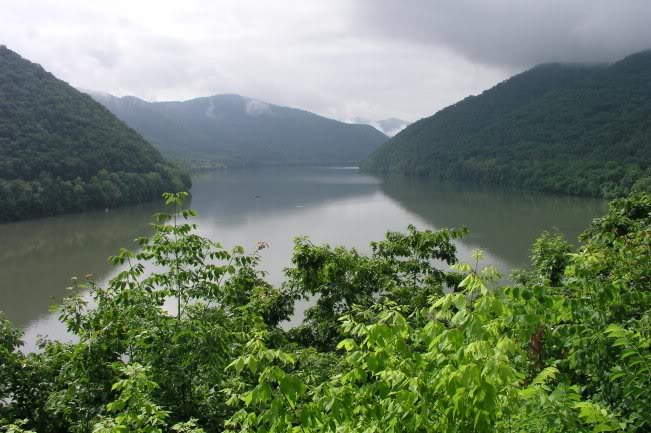 In Sunday Train last week, I referred to the Bipartisan Majority to Authorize the funding of Amtrak as "Good News". One commentator in the discussion in one of the crossposts pointed out that the news wasn't all that particularly good, since continued funding on this basis over the indefinite future will spell serious trouble for the system as a whole.
In Sunday Train last week, I referred to the Bipartisan Majority to Authorize the funding of Amtrak as "Good News". One commentator in the discussion in one of the crossposts pointed out that the news wasn't all that particularly good, since continued funding on this basis over the indefinite future will spell serious trouble for the system as a whole.
Now, as I suggested more than once, the "good news" last week certainly was not unqualified good news ... that is, to say it was "qualified" good news was already taking on board the bad electoral news for Amtrak in the continued Republican House Majority combined with a new Republican Senate Majority, which opened the door to some of the deep, slashing cuts to Amtrak that some on the Republican side have long hoped to make. So the "qualified good news" was that in going for a total defunding of Amtrak, the radical reactionary wing of the Republican party overplayed its hand, opening the way for a majority of House Republicans, along with basically the entire Democratic caucus, to authorize the continued funding of Amtrak at just about the levels that have been in place over the past four years.
But that was set against the bad news of the INDOT refusing to continue the Hoosier State service on the ground of basically not being allowed to have its cake and eat it too ... insisting on acting like the organization putting together a passenger rail service, without being treated as a passenger railway. And so I started thinking about the Hoosier State / Cardinal corridor in the context of, on one hand, the very low bar for "good news" in transport funding with this Congress, versus the tremendous need we have for a massive wave of investment in transport that can be powered by sustainable, renewable energy. And to organize my thinking, I started to sort it out into five levels:
- Level 0: "Very Much Worse";
- Level 1: "Barely Scraping By";
- Level 2: "A Basic Skeleton Service Done Right"
- Level 3: "Incremental Growth"
- Level 4: "Aggressive Growth"
More about the five levels ... below the fold.
Level 0: Very Much Worse
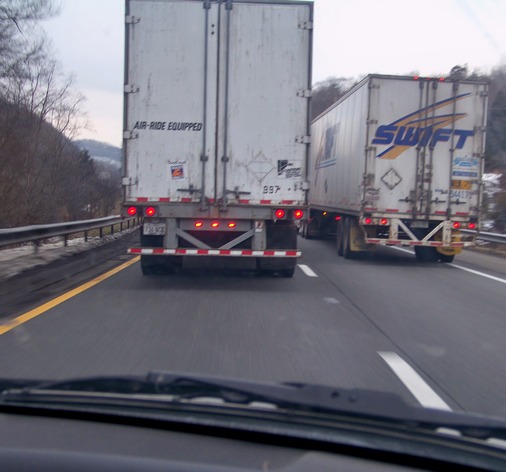 The fact that last week's Amtrak funding news was qualified good news primarily in the negative sense that it could have been much worse laid out for me the baseline level, which is that "much worse" that it certainly would have been had the radical reactionaries got their way.
The fact that last week's Amtrak funding news was qualified good news primarily in the negative sense that it could have been much worse laid out for me the baseline level, which is that "much worse" that it certainly would have been had the radical reactionaries got their way.
In Level 0, we basically abandon any efforts to establish intercity rail policy to the States, in support of the already powerful fossil fuel and road-building empire lobbies. We throw all hope of any progress in sustainable intercity transport on the gadgetbahn solutions of electric, possibly driverless, cars. We pretend that the unraveling Federal Highway Fund is not facing a structural crisis, due to the financial unsustainability of "everybody else subsidize the suburbs" once the subsidy suburbs have grown to have as many people as all of the urban and rural donor areas taken together. Instead, we patch things together with short term band-aids while dumping any efforts to offer alternatives that take the burden off of the overstretched Interstates on the laps of states and cities.
This is the level that is well suited to that section of the elite establishment that has clearly given up on the United States as having any hope of brighter days ahead of it as a nation, and so we should just keep patching the decaying infrastructure that we built in a brighter day and they should work out how to grab an ever larger share of the pie so that they can "afford" rely on an exclusive private infrastructure of helipads and private airports.
What this level means for the Hoosier State and the Cardinal is obvious: all fifteen of the long-haul services are shut down, the Hoosier State is shut down, the state supported corridor services in states that have used higher total subsidies to drive up frequencies and drive down subsidies per passenger mile see their progress certainly slowed, in many cases halted, in some cases reversed. The Northeast Corridor returns to the path of the massive physical depreciation of the most economically important passenger rail corridors in the country that preceded the Penn Central bankruptcy that originally set up Amtrak.
As with all "no money down, pay later" schemes, the up front bill for Level 0 is quite modest, $0/person annually. What is the long term cost in terms of lost opportunities to the nation's economy?
Its hard to tell how much damage this path does the country, since if we project this approach to national infrastructure investment strategy, the end result is the collapse of the United States as a coherent national economy and national society, and depending on how quickly the collapse comes, the NEC might still be operating on a duct tape and bailing wire basis when it happens.
Level 1: Barely Scraping By
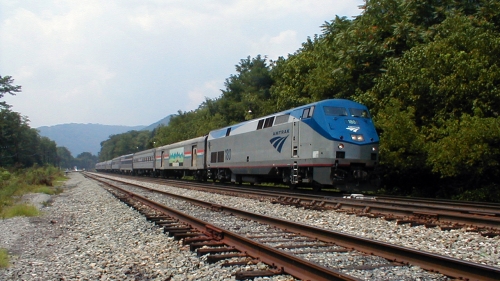 This was the qualified good news of last week ... that we weren't opting for Level 0, despite the fervent desire of many in the Majority caucus in the House of Representatives that we do so.
This was the qualified good news of last week ... that we weren't opting for Level 0, despite the fervent desire of many in the Majority caucus in the House of Representatives that we do so.
But Level 1 is not, in fact, a long term sustainable position. While we may be able to scrape by for a few more years, the longer we attempt to get by, the closer "barely scraping by" approaches Level 0. It still means that rather than returning the NEC to a state of good repair, we are trading off needed investments against needed maintenance. The plans that have been worked out, under Congressional mandate, to bring all long-haul passenger services to 40% or better farebox cost recovery and provide incremental improvements in quality of service across the board will mostly stay on the shelf.
The price is a bit higher than for Level 0 ... we know that it was roughly $1.3b annually authorized for our current Level 1 authorization, which is about $4/person, annually.
As far as the cost of Level 0, the next time that there is an oil price shock, we will come into it with a long haul interstate passenger rail system that is less capable of contributing to transport alternatives than the one we had when we entered the 2006-2008 oil price shock.
For the Hoosier State / Cardinal, it means that the INDOT shuts down the daily service overlay on the Cardinal path, and, eventually, the Cardinal will get the knife, along with the Sunset from NOLA to LA(CA). And with those shutting down, when people turn around and conclude that it would be worthwhile to pursue an upgraded service on that corridor, it will be substantially more difficult to get one started.
Level 2: A Skeleton Service Done Right
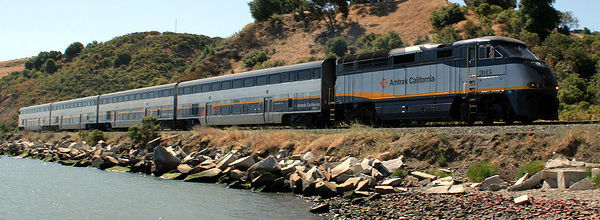 We have a reasonably good idea what level of funding it would take to do the current Amtrak "Skeleton Service" right, since that was the level of funding authorization that was won in the previous round of Amtrak funding. That is about 40% more funding than the Barely Scraping By level, so about $1.8b annually, plus additional funding in the Transportation Authorization that states and cities can use to leverage investments in multi-modal stations and corridor capital improvements that spill over to the benefit of the Skeleton Intercity passenger system.
We have a reasonably good idea what level of funding it would take to do the current Amtrak "Skeleton Service" right, since that was the level of funding authorization that was won in the previous round of Amtrak funding. That is about 40% more funding than the Barely Scraping By level, so about $1.8b annually, plus additional funding in the Transportation Authorization that states and cities can use to leverage investments in multi-modal stations and corridor capital improvements that spill over to the benefit of the Skeleton Intercity passenger system.
The price is more like $6/person/yr (a little less, but closer to $6/person/yr than $5/person/yr). What we get from consistently funding the current Skeleton system on a long term sustainable basis is modest but incremental improvement on the current system ... because we have been underfunding the system, on average, for so long that the movement toward long term stability is an upward trajectory in the short and medium term.
Given a long term stable funding source and so the ability to negotiate patiently, one of the things that the Skeleton System done right level of funding would likely allow is to put the two heavily-money-losing three-days-a-week services on a daily basis.
These services are essentially guaranteed to be less efficient in their use of rolling stock. A three day a week schedule has to operate with one, one, and two days between departures from each side of the route. That means that it has to have the trainsets that would allow it to run a "seven days per fortnight" schedule. However, a less-than-daily train has to run on the same days of the week each week to have any chance at all of people making sense of the schedule, so each trainset has to have an extra day sitting still doing nothing at one side of its route or the other.
And operating three days a week cuts the service from a wide range of the type of round trips that a daily service can cater to ... such as, for example, the one day seminar on the Steel Interstate that I attended in DC. A "depart next day after arrival" schedule would left me in DC for an extra day, and the extra cost of hotel would likely have made flying cheaper. A "depart second day after arrival" would have worked well if the seminar was timed to match ... but even worse than the day after arrival if the seminar was timed to run on the day that the train arrived in DC.
Now, clearly, the once a day train is far from ideal, since it will often mean that for that type of trip, two days in a hotel are needed for a full-day event ... the day before, because the train arrived in the middle of the event, and the day of the event, because the train leaves in the middle of the event.
But actually, the evening after the event was used to network and socialize, so the hotel the night of the seminar was really needed to get the full benefit from the seminar. Given a "safe, not sorry" airplane scheduling strategy in the middle of our increasingly violent winters would have left me needing two days in hotels anyway if I had flown without attempting to arrive on the morning of the seminar. So the daily Capital Ltd. scheduling ended up serving me reasonably well, except for the absurd time of night that it runs through Northeastern Ohio each way.
And a three-days-a-week service like the Cardinal just wouldn't have cut it, if I had happened to be leaving from Southwest Ohio and looking to catch a train in Cincinnati. I would at most have taken it one way, and would have had to fly back.
Looking through the various Congressionally-mandate plans to improve service, upgrading the Sunset Ltd and Cardinal to daily would be the biggest improvements in quality of service on any route that would become possible from adopting a "Skeleton Service Done Right" Level 2 approach. But there would be improvements across the board. Rolling stock long past their expiration date would be allowed to retire from service and new rolling stock would replace it, with lower operating costs for the railway and a range of amenities for passengers, including a fading of the risk, as reported in the comments section of one edition of last week's Sunday Train, of being caught in a delayed train where half of the toilets do not function properly.
Those who never use the Skeleton Service might not even notice the benefits, because much of the benefit is in the avoided consequences of continued underfunding, and we frequently pay little attention to "the dog that does not bark". So the "middle of the pack" services, including the two other Chicago to East Coast services, the Lakeshore and the Capital City, would not likely see any big splash upgrades in service, but they would be likely to enjoy more modest improvements, in both quality of equipment and in terms of quality of station facilities and inter-modal access at various points along their route.
As far as the Hoosier State, the daily Cardinal would avoid one of the biggest costs of abandoning the Hoosier State: the difficulty of upgrading corridor service when there is no already a daily service operating in the corridor.
Level 3: Incremental Growth
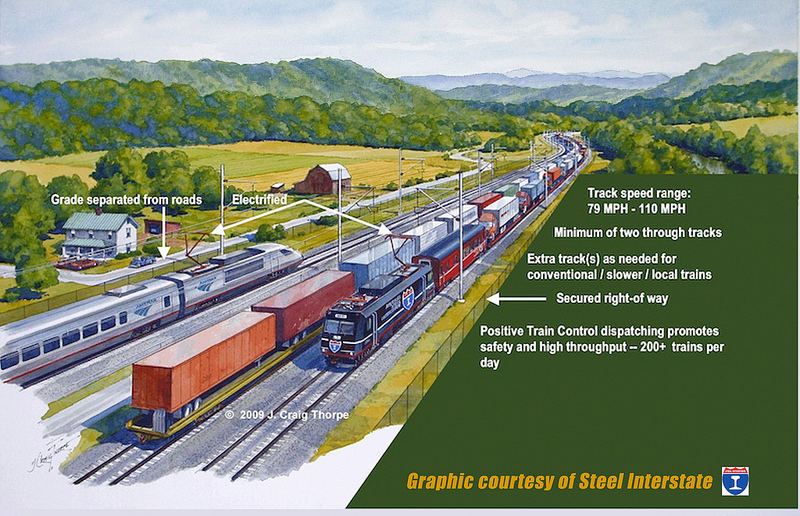 To take the next step up, I am going to flip the above "price tag" analysis on its head. Instead of having an annual total price tag and dividing by the national population to arrive at a price per person, per year, I'm going to start with an annual price tag per person, per year, and look at the total sum that this implies. What if instead of about $6/person/yr, we spent about $12/person/yr? What kind of intercity rail transport alternative would we be equipping our country with?
To take the next step up, I am going to flip the above "price tag" analysis on its head. Instead of having an annual total price tag and dividing by the national population to arrive at a price per person, per year, I'm going to start with an annual price tag per person, per year, and look at the total sum that this implies. What if instead of about $6/person/yr, we spent about $12/person/yr? What kind of intercity rail transport alternative would we be equipping our country with?
This is $3.8b, and $1.8b of that $3.8b, is already spoken for, in terms of maintaining the system that we already have on an ongoing basis. So we would have $2b to invest annually in capital improvements.
What we would get is a healthy combination of placing the existing Skeleton System on a sustainable basis and an upgrade on the kind of incremental improvements that we funded during 2009 and 2010, in the Stimulus II package set-aside of $8b for "high speed rail", along with the more modest $2.5b that we added on top in the following annual budget.
Just as the $8b Stimulus was divided between "Express" HSR and the quality of passenger service I have been calling "Rapid Passenger Rail", this $2b additional capital funding could be divided into two $1b pots. One pot would go to "Express HSR" corridors, which at present means being split between the California HSR system and new capital investments along the NEC corridor to upgrade it to the transit speed that a 150mph service ought to have ... that is, making it a "real" 150mph service, rather than the transit speed of a 110mph, with the bonus feature of every once in a while reaches speed of 150mph to be able to boast about its top speed. In the NEC, this would mean some of the upgrades along the lines discussed in the Sunday Train of 15 July, 2012. In California, this would mean a slower roll-out than originally envisioned, but would enable the critical first Operating Service from north of Fresno through to the LA Valley to be built.
The other pot would go into establishment of 110mph corridor services with multiple daily services along the lines of the Chicago to St. Louis, and part of the Chicago to Detroit corridors that have been funded, and currently being planned for the DC to Richmond corridor, and upgrades to capacity to build frequencies on conventional services as the preliminary step toward upgrading them to 110mph corridors, such as the investments in the Cascade Corridor.
This is the level where things start to get interesting along the Cardinal corridor. Given a common 110mph "South of the Lake" corridor without freight conflicts from Chicago Union Station through to Gary Indiana, as part of the planning further upgrades to the Chicago to Detroit corridor, then Chicago to Indianapolis becomes a target for a 110mph corridor. Then upgrading (!) the Indianapolis to Cincinnati to a 60mph (!) conventional rail corridor allows a daily Chicago to Cincinnati service to leave Chicago in the morning, run to Cincinnati via Indianapolis, and return from Cincinnati to Chicago via Indianapolis that evening. On top of that, a service that leaves Indianapolis to Chicago in the morning can return to Indianapolis for mid-day / early afternoon, and arrive in Chicago to depart back for Indianapolis after close of business in Chicago. So we have three corridor services each way between Indianapolis and Chicago, and one corridor service each way between Cincinnati and Chicago.
But there's still more, since if the upgrade on the Cincinnati to Indianapolis leg of the Cardinal is combined with a 110mph Rapid Passenger Rail upgrade on the corridor between Cleveland and Pittsburgh, the Cardinal can be re-designed into the "DC Loop" which I discussed back in June of 2012. In this system, the Cardinal relies on the expanded passenger capacity of the NEC to provide through ticketing from DC to NYC on the NEC Regionals, and the two long-distance Chicago to DC corridors are turned into a single loop, with one route running from Chicago to DC via Cleveland and Pittsburgh, then returning to Chicago via Charlotte WV, Cincinnati and Indianapolis, and the other route running the reverse.
The kicker here is that with these upgrades, the "Chicago / DC Loop" route would be able to send a train out of Chicago to DC in one direction at twelve hour intervals, and the first train could be brought back to Chicago, serviced and be ready to start over again in a day and a half. So while the Chicago to DC route via Cleveland and Pittsburgh requires three trainsets, and the daily Chicago to NYC via Cincinnati, Charlotte WV and DC requires three trainsets, a twice daily Chicago to Chicago via both Cleveland, Pittsburgh, DC, Charlotte WV and Cincinnati, and Cincinnati, Charlotte WV, DC, Pittsburgh and Cleveland requires six trainsets. So by handing off the DC to NYC portion of the Cardinal to through ticketing with the NEC regionals, and upgrading key sections of the existing corridors, we get twice daily each way service on both corridors.
Twice daily service on long-haul corridors is great, since station along the way is ever stuck with being one of the "only in the middle of the night" stations. Along our expanded Hoosier State route, it means that Indianapolis / Chicago gets five times a day service ... twice each way, each day from the Cardinal leg of the DC loop, one time each way each day on the Chicago/Cincinnati corridor service, and twice each day on the Indianapolis/Chicago corridor service. And Cincinnati gets three times a day service to both Chicago and Indianapolis. With multiple daytime services on the corridor, its likely that the Oxford stop could be added for Miami University (of Ohio)'s substantial Cincinnati based and Chicagoland based student populations.
There is another dimension to the Incremental Improvement level, and that is on the freight side. As discussed in Sunday Train at various times, the Steel Interstate system is an approach to the upgrade of our freight rail system that includes electrification of existing heavy freight rail corridors as well as new investment in track and other infrastructure to establish up-to-90mph "Rapid Freight Rail" paths for single stack container traffic, low profile truck intermodal piggyback traffic, and specialized general freight traffic, to wind back from heavy truck freight the much higher value, more time-sensitive and delivery-reliability-sensitive, freight markets that rail has largely conceded to heavy trucks over the past half century.
As discussed by one of the participants in the 2015 Steel Interstate "Future of Rail Technical Symposium" in DC, which I attended, the Steel Interstate can be launched on a trial basis on one extended corridor under funding mechanisms already set in place and within the funding limits already allowed for, so a trial Steel Interstate could be launched by a cooperative group of states establishing a Steel Interstate "Infrastructure Development Authority". However, while the Steel Interstates can be established on a self-funding basis, the funding mechanisms that are available for a pilot Steel Interstate corridor in one extended corridor are not sufficient for multiple corridors. So an additional dimension of the Incremental Improvement level is, on the freight side, establishment of a distinct category of Qualified Private Activity Bond entitlements for Steel Interstate development, with a capital limit sufficient for the number of Steel Interstate corridors that cooperative groups of states wish to establish.
Now, after giving a quick sketch of what this level of funding might entail in one corridor (and giving links to what it might entail elsewhere), you might be expecting me to end this section on a high note.
Except ... while Level 3 would provide a substantially better foundation from which to launch a push toward a long-term sustainable transport system, able to bring our nations society and economy through the coming emergency years of this century largely intact as a national economy and society ... it is not that push. On its own, it is not enough. It is not like Level 1, where we are rearranging the deck chairs on the Titanic, or Level 0, where we are preparing for an emergency on the Titanic by knocking holes in the bottoms of the lifeboats ... (and in those terms, the "good news" of last week is that instead of knocking holes in the bottoms of the lifeboats, as the radical reactionary wing of the Republican party threatened, and which after November's election results they very well might have been able to do, the Congressional majority voted to instead re-arrange the deck chairs) ... but it is still not the same as being able to steer the Titanic sharply enough to avoid a crippling blow.
Level 4: Aggressive Growth
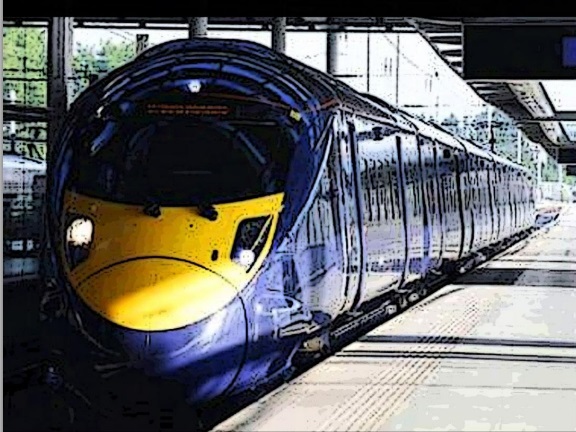 To think about what would be enough, I return to my "Pedal to the Metal" essays from the Sunday Train, first about Freight Rail, and second about Passenger Rail (and apologies for any image bit-rot in the interim).
To think about what would be enough, I return to my "Pedal to the Metal" essays from the Sunday Train, first about Freight Rail, and second about Passenger Rail (and apologies for any image bit-rot in the interim).
On the Freight Rail side, while the Steel Interstates can be rolled out on a self-funding basis, it is faster to roll them out on the basis of subsidizing the interest cost of their bonds. This means that the access and user fees pay off their original capital funding more rapidly, and then can be themselves used to allow additional borrowing more rapidly. There the interest rate subsidy starts at $0.5b and is increased in annual increments of $0.5b to $4.5b. This progressive ramp up of funding tracks the way that the project would be pursued if pursued on the basis of full commercial urgency, in a process of steadily training work teams and setting them to work, so that there is a steadily growing workforce completing a growing numbers of track-miles per year, in line with the growth in the bonds that can be raised on the back of the interest subsidy.
On the Passenger side, a Pedal to the Metal approach to Rapid Passenger Rail would launch 5 corridors a year over an eight year period. With a year to finalize planning of the corridors already well studied and two years to complete a corridor, this is 40 corridors completed in a ten year period. This would be roughly 12,000 miles of electrified 110mph Rapid Passenger Rail corridor. If this cost on average $10m/mile, that would be $120b, or $12b/year.
While opportunities for Express HSR corridors that justify their substantially higher capital cost are much more limited than opportunities for Rapid Passenger Rail corridors that can be served without operating subsidy ... the flip side of this is that where those opportunities exist, they would serve quite a lot of people annually, and however many of them we build in these early years of the Emergency Century, our children and grandchildren will surely thank us. So let me match the $4.5b/yr of the Pedal to the Metal Steel Interstate roll-out ... and unlike the Steel Interstate and Rapid Passenger Rail corridor roll-outs, extend that past the ten-year "leading edge" planning horizon into a twenty year horizon ... and, of course, fund it on a stable real-cost basis.
There are network economies for Express HSR in making a collection of pushes side-by-side like this. For one thing, where today an Express HSR system has to include funding for the Rapid Passenger Rail corridor through a densely settled urban area into a central urban station, under this system many of those corridors would already exist, as the original French TGV systems were able to rely on existing Express Passenger Rail corridors into Paris ... because they will have been recently developed as part of the more rapidly completed Rapid Passenger Rail corridor build-out. At the same time, where at present an Express HSR system may have to trade passengers cross-platform with a conventional rail system that is equipped to run out onto the conventional heavy rail network, an effective build out of Rapid Passenger Rail corridors means that it can run through into either the Rapid Passenger Rail or Steel Interstate networks, allowing the same incremental speed upgrades enjoyed by the earliest French TGV services as the different phases of the first TGV corridor were brought into service.
So let us go back to the Cardinal corridor. Now there is a 220mph Express HSR corridor being constructed from Chicago to St. Louis via Champaign, with a leg from Champaign to Indianapolis. When it is completed, there will be is an hourly Chicago train from Cincinnati on the Rapid Passenger Rail corridor to Indianapolis that continues on the Express HSR corridor to Chicago via Champaign. There is already a Rapid Passenger Rail corridor service that operates from Cincinnati to Chicago via the 110mph corridor through Northwest Indiana multiple times during the day, with two or more Cardinal services operating between Chicago and DC on the Chicago to Cincinnati Rapid Passenger Rail corridor and the Steel Interstate corridor running through West Virginia, connecting to a Rapid Passenger Rail corridor running into DC.
This adds up to $21b/yr, or $65/person/yr. Of course, we get much more for it than we do for $12/person/yr. One thing we get from it is that long-distance "sleeper" passenger trains that primarily provide service connecting regional centers and remote rural areas to major metropolitan areas would be able to operate with a sufficient numbers of sections generating an operating surplus that the radical reactionary demand that Amtrak should run without operating surpluses ought to be able to be met.
Its just that this demand would be met with a far more dramatic investment in the ongoing future of the United States as a single national project, representing far more confidence in the United States as a single national project, than they seem to be willing or able to envision.
Conclusions and Considerations
Politics is about choices. As we look ahead at policy making in the decade of the 2020's, those choices will become increasingly polarized between those who wish to make the dramatic investments necessary to restructure the United States and give it an at least fighting chance of surviving this Emergency Century intact ... and those who wish to retreat into a fantasy world in which we can continue the policies that created the Emergency Century, and which have already started coming unstuck in the first two decades of the Emergency Century, and somehow, magically, escape the natural, physical consequences of that choice.
Last week, the US Congress decided to not knock holes in the bottoms of the life-rafts. Which is better than deciding to do so ... but those of us who can see the Emergency Century coming should be looking ahead, both to what kind of politics we will be wanting to make if we can convince a majority of our fellow citizens to support the ongoing survival of our two-century-long national project ... and to how much of a foundation we can build to support that effort in the interim as larger numbers, but falling short of a majority, see the urgency of beginning the process of a sustainable national renascence.
But that's just my opinion. What do you think?
Comments
Most of the ruling establishment is asleep ...
... but how can they sleep when their beds are burning?